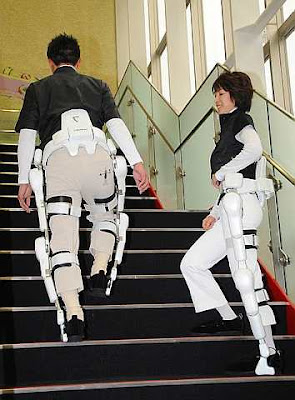
Robotic suits named HAL, or "hybrid assistive limb," are shown by Yoshiyuki Sankai, a University of Tsukuba professor and new company Cyberdyne chief executive who designed HAL, explains during a press conference at the headquarters of Cyberdyne in Tsukuba, outside Tokyo, Tuesday, Oct. 7, 2008. HAL, that reads brain signals and helps people with mobility problems, will be available to rent in Japan for US$2,200 for both legs and $1,500 for a one leg a month starting Friday _ an invention that may have far-reaching benefits for the disabled and elderly.

Robotic suits named HAL, or "hybrid assistive limb," are worn by models as Yoshiyuki Sankai, right with a microphone, a University of Tsukuba professor and new company Cyberdyne chief executive who designed HAL, explains during a press conference at the headquarters of Cyberdyne in Tsukuba, outside Tokyo, Tuesday, Oct. 7, 2008. HAL, that reads brain signals and helps people with mobility problems, will be available to rent in Japan for US$2,200 for both legs and $1,500 for a one leg a month starting Friday _ an invention that may have far-reaching benefits for the disabled and elderly. Listening to Sankai is Cyberdyne chief operating officer Mitsuhiro Sakamoto.


Yoshiyuki Sankai, left, a University of Tsukuba professor and chief executive of new company Cyberdyne, explains about the robotic suit named HAL, or "hybrid assistive limb, he designed during a press conference at the headquarters of Cyberdyne in Tsukuba, outside Tokyo, Tuesday, Oct. 7, 2008. HAL, that reads brain signals and helps people with mobility problems, will be available to rent in Japan for US$2,200 for both legs and $1,500 for a one leg a month starting Friday _ an invention that may have far-reaching benefits for the disabled and elderly.










No comments:
Post a Comment